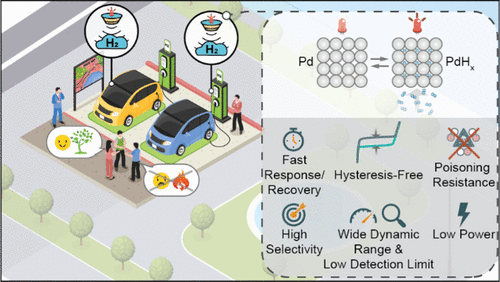Our official English website, www.x-mol.net, welcomes your
feedback! (Note: you will need to create a separate account there.)
High-Performance Nanostructured Palladium-Based Hydrogen Sensors—Current Limitations and Strategies for Their Mitigation
ACS Sensors ( IF 8.2 ) Pub Date : 2020-11-12 , DOI: 10.1021/acssensors.0c02019 Iwan Darmadi 1 , Ferry Anggoro Ardy Nugroho 2, 3 , Christoph Langhammer 1
ACS Sensors ( IF 8.2 ) Pub Date : 2020-11-12 , DOI: 10.1021/acssensors.0c02019 Iwan Darmadi 1 , Ferry Anggoro Ardy Nugroho 2, 3 , Christoph Langhammer 1
Affiliation

|
Hydrogen gas is rapidly approaching a global breakthrough as a carbon-free energy vector. In such a hydrogen economy, safety sensors for hydrogen leak detection will be an indispensable element along the entire value chain, from the site of hydrogen production to the point of consumption, due to the high flammability of hydrogen–air mixtures. To stimulate and guide the development of such sensors, industrial and governmental stakeholders have defined sets of strict performance targets, which are yet to be entirely fulfilled. In this Perspective, we summarize recent efforts and discuss research strategies for the development of hydrogen sensors that aim at meeting the set performance goals. In the first part, we describe the state-of-the-art for fast and selective hydrogen sensors at the research level, and we identify nanostructured Pd transducer materials as the common denominator in the best performing solutions. As a consequence, in the second part, we introduce the fundamentals of the Pd–hydrogen interaction to lay the foundation for a detailed discussion of key strategies and Pd-based material design rules necessary for the development of next generation high-performance nanostructured Pd-based hydrogen sensors that are on par with even the most stringent and challenging performance targets.
中文翻译:

高性能纳米结构钯基氢传感器——当前的局限性及其缓解策略
作为无碳能源载体,氢气正在迅速接近全球突破。在这样的氢经济中,由于氢气-空气混合物的高度易燃性,用于氢气泄漏检测的安全传感器将成为从氢气生产现场到消费点的整个价值链中不可或缺的元素。为了刺激和指导此类传感器的发展,工业和政府利益相关者制定了一系列严格的性能目标,但尚未完全实现。在本视角中,我们总结了最近的努力,并讨论了旨在满足既定性能目标的氢传感器开发的研究策略。在第一部分中,我们描述了研究层面的快速选择性氢传感器的最新技术,并且我们将纳米结构 Pd 传感器材料确定为性能最佳解决方案的共同点。因此,在第二部分中,我们介绍了 Pd-氢相互作用的基本原理,为详细讨论开发下一代高性能纳米结构 Pd- 所需的关键策略和 Pd 基材料设计规则奠定了基础。基于氢传感器,即使是最严格和最具挑战性的性能目标。
更新日期:2020-11-25
中文翻译:

高性能纳米结构钯基氢传感器——当前的局限性及其缓解策略
作为无碳能源载体,氢气正在迅速接近全球突破。在这样的氢经济中,由于氢气-空气混合物的高度易燃性,用于氢气泄漏检测的安全传感器将成为从氢气生产现场到消费点的整个价值链中不可或缺的元素。为了刺激和指导此类传感器的发展,工业和政府利益相关者制定了一系列严格的性能目标,但尚未完全实现。在本视角中,我们总结了最近的努力,并讨论了旨在满足既定性能目标的氢传感器开发的研究策略。在第一部分中,我们描述了研究层面的快速选择性氢传感器的最新技术,并且我们将纳米结构 Pd 传感器材料确定为性能最佳解决方案的共同点。因此,在第二部分中,我们介绍了 Pd-氢相互作用的基本原理,为详细讨论开发下一代高性能纳米结构 Pd- 所需的关键策略和 Pd 基材料设计规则奠定了基础。基于氢传感器,即使是最严格和最具挑战性的性能目标。











































 京公网安备 11010802027423号
京公网安备 11010802027423号